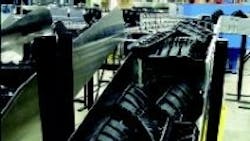Modular Conveyors Enhance Production Line Agility
Modular conveyor systems provide automotive parts supplier with added flexibility, simplified replacement parts inventory and easier maintenance.
Production agility is vital to many manufacturers today, more so in the auto parts sector than many others. Although auto parts companies have dedicated production lines for continuous runs of components and assemblies, such setups can benefit from the ability to quickly reconfigure, fine tune and service equipment, including conveyor systems.
"In this business, you've got to be fast on your feet," says Bruce Wakefield, senior project engineer for Mann+Hummel Automotive (South Bend, Ind.), a supplier of three-part injection-molded plastic manifolds for four-cylinder General Motors engines, and a four-part assembly for eight-cylinder DaimlerChrysler engines. The Mann+Hummel manifold plant requires a high degree of efficiency and flexibility.
"There are varying factors we must consider when making production decisions," Wakefield explains. "We have major investments in production equipment and stringent delivery requirements for finished products. To ensure that we can meet our primary commitments, we may have excess production capacity that we can sell. At the same time, we must avoid downtime, which requires being able to service our production lines quickly, including any necessary reconfigurations and repairs."
The manifold production lines include conveyors that feed three 1,750-ton presses located in three cells. Work in process goes from the presses to a collect chute, where operators put parts in totes that continue on to workstations where automatic welding takes place.
The original conveyor system installed when the plant was built in 1989 was a fixed steel design, with runs varying to approximately 80 ft. Although the conveyors performed reliably, there were circumstances when they did not offer the flexibility or ability to "tweak" a configuration that would have helped material flow. When manifold designs changed, the molding cells needed to be reconfigured, which in some instances meant ordering new conveyors.
Mann+Hummel first replaced the conventional steel conveyors on a secondary line with a DynaCon modular plastic conveyor system manufactured by Dynamic Conveyor Corp. (Muskegon, Mich.). The trial conveyor system proved to be reliable and its modular design offered flexibility.
"We had a tight arrangement in one cell, and the Dyna-Con system made it a lot easier to bring the parts in on the conveyor," Wakefield says. "We put an angle on the end of the conveyor to be more ergonomic with the positioning of the parts to the operator. With the flexibility of the system we were able to try a 30-degree or 45-degree angle to the conveyor as we were laying out the cell on paper. It gave us a lot of flexibility in our floor plan layout. Plus, the system gives us a lot of flexibility down the road if we want to move some gear, reconfigure the cell, add a piece of equipment or take one out. And it's easy to reconfigure the conveyor. That's a big advantage because with automotive programs that have a definite life, your cell is eventually going to be obsolete."
Standard DynaCon conveyor system modules include drive flights, side guards, retaining walls, legs and connectors. A variety of accessories, such as cooling tunnels, separators, and water bath tanks are available.
Dynamic Conveyor Corp., www.dynamicconveyor.com
DynaCon's modular conveyor system enhances production-line agility and cost savings at Mann+Hummel.
